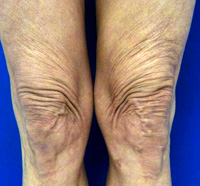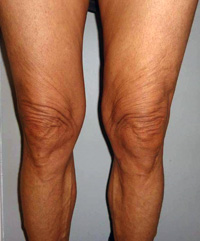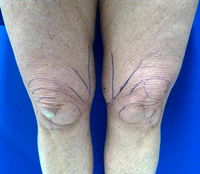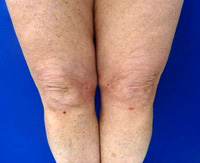Why worry about knees and their appearance?
Aging is an ongoing process that can affect essentially any and every part of human body. Although many procedures exist to possibly reverse the signs of aging on head and neck area, limited options exist for procedures elsewhere on the body.
► Watch Video
Knee Contouring, As Seen on PIX11 News
► Watch Video
Watch Dr Khan performing Knee Contouring Surgery as seen on abc news
For some people excessive wrinkles and sagging of the skin over the knees can be quite noticeable. Improvement in the skin texture and appearance of wrinkling of the skin over the knees although quite desirable, is not a very popular procedure. Most importantly, because of limited options that exist to reverse the signs of aging in such a sensitive area. Lack of expertise in this area and due to a limited number of options available make it even harder to offer best possible treatment options to patients who might even be interested in improving the look of their sagging skin over the knees.
Dr Misbah Khan has pioneered a minimally invasive surgical technique that can help to tighten the knees without any skin loss and minimal downtime.
The objective of this procedure is to improve the contour and texture of the skin over the knees without any skin loss by a minimally invasive procedure.
 |
 |
|
| BEFORE | AFTER |
Few details about the Knee Contouring Procedure:
- Patient selection:
Adult healthy male or female, with excessive wrinkling and sagging of the knee skin would be good candidates for this procedure. Patients with a history or osteoarthritis and / or knee replacement surgeries are excluded from the procedure. Patients with a history of other forms of arthritis such as Rheumatoid arthritis are also excluded from the procedure. Patients who have allergy to numbing medicine called Lidocaine (frequently used by dentists for dental procedures) are also excluded from the procedure. - Procedure details:
The patient is first evaluated in standing position for the areas of correction, any underlying deformities and the extent of skin wrinkling is determined. Areas to be corrected are marked and further discussed with the patient to ensure the accuracy of the procedure.
The procedure is performed in an out-patient setting under local anesthesia.
 |
 |
|
| BEFORE | AFTER |
The procedure involves making at least 2 or 3 incisions that are 2-mm in size placed in the skin creases around the knee joint. Local anesthesia is injected underneath the skin to completely numb the area. The numbing medicine is allowed to infiltrate into the skin and surrounding soft tissue for at least 1 hr.
Areas with excessive fat that give rise of what we call “knobby knees” are contoured by very gentle liposuction using vibrational cannulas. During this process some of the fat is loosened and pushed into the areas under the skin where there is complete lack of underlying soft tissue due to volume loss with age. If the patient is very thin and has thin skin over the knees without much localized fat, then liposuction part of the procedure can be omitted. However, vibrational cannulas alone without the liposuction can be used to release the skin that is bound down to the underlying soft tissues creating a bunched up appearance.
The second step is the insertion of a laser fiber under the skin for skin tightening. Low-level laser light is used for gently heating the skin on the under surface. This gentle heat on the under surface stimulates the skin to produce new collagen. This process of new collagen formation occurs over time. That in part might be responsible for continued improvement in the knee skin contouring as seen over time (weeks to months) after the procedure.
The third step is the fractional laser resurfacing on top of the skin. This final step in the process is very essential as one must address the skin changes that appear on the surface of the skin, not only underneath the skin.
Recovery from the knee contouring procedure:
Recovery from this procedure takes one day. Patients see the results immediately after the procedure. After leaving the office the patients can do their house-hold chores but preferably stay at home for 1 day. The patients experience some level of discomfort for at least 24 hours.
However, after one day the discomfort subsides and patients can get back to work and live their lives like they normally would. Mild to moderate level of exercises are encouraged.
Patients are asked to return for a follow up visit in 6 weeks and then at 6 months in order to make sure the patients are satisfied and have no complaints.
In order to find out more about the procedure schedule your consultation with Dr Khan at her Manhattan office


